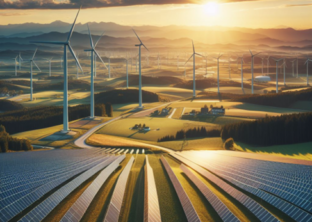Bioenergy from microalgae

The cultivation of energy crops such as corn leads to land competition with food production and to monocultures that are ecologically almost worthless. In the meantime, there are much more environmentally friendly concepts for generating energy from biomass. One solution would be microalgae instead of corn.
Microalgae can reach lipid contents of up to 70 % and starch contents of up to 60 %. They grow considerably faster than land plants and require hardly any nutrients or pesticides. Photobioreactors are the most commonly used method of microalgae production in Europe. In long glass tube systems, the single-celled organisms are optimally supplied with sunlight. There are already entire recirculation concepts, such as those developed by Fraunhofer IGB: According to these, first the valuable substances for food additives or cosmetic and pharmaceutical applications are extracted from the algae and then the residual biomass is fermented in a biogas plant. After generating heat and electricity from biogas in a combined heat and power plant, the CO2 produced can be recycled and used for cultivating the algae.
The principle is easy to understand and not new. However, there is hardly any experience with the production of microalgae for biogas production on a relevant scale. Back in 2013, the first so-called algae house was built in Hamburg’s Wilhelmsburg district. It has a 200-square-meter green glass façade made of flatbed bioreactors that simultaneously insulate against heat and sound. Here, algae can photosynthesize and form biomass that can be skimmed off, used to produce energy for the house. In Wilhelmsburg, 15 residential units with a total area of 1,600 square meters are supplied with hot water and heating by this facade technology. Last year, the Primono Group and Cellparc entered into a cooperation to further advance the concept of highly efficient bioenergy facades. New projects are to be implemented.
There is no question that innovative heating concepts in particular are urgently needed, but unfortunately the costs are still very high and economies of scale are needed to change this.

Doris Höflich, Market Intelligence Senior Expert
Quellen:
- Fraunhofer IGB
- PV Magazine, 06.10.2021







